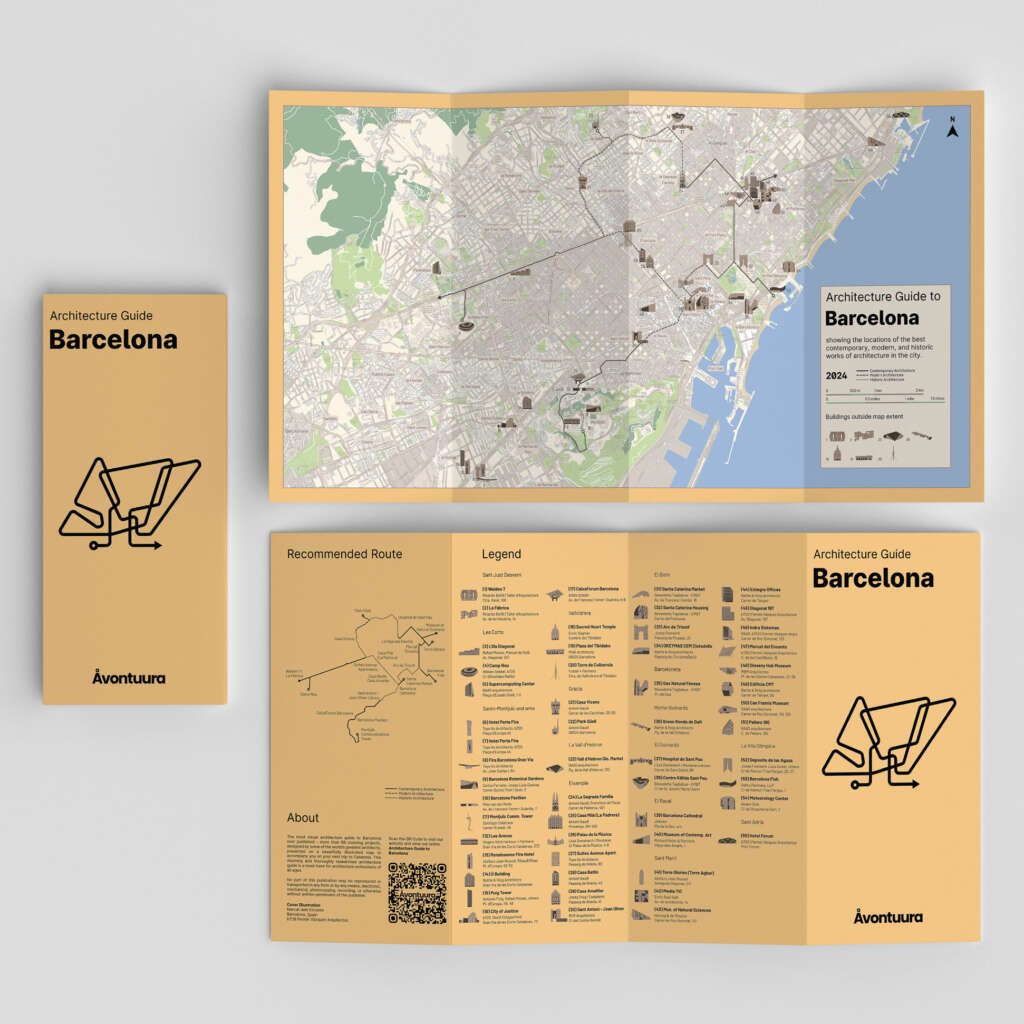
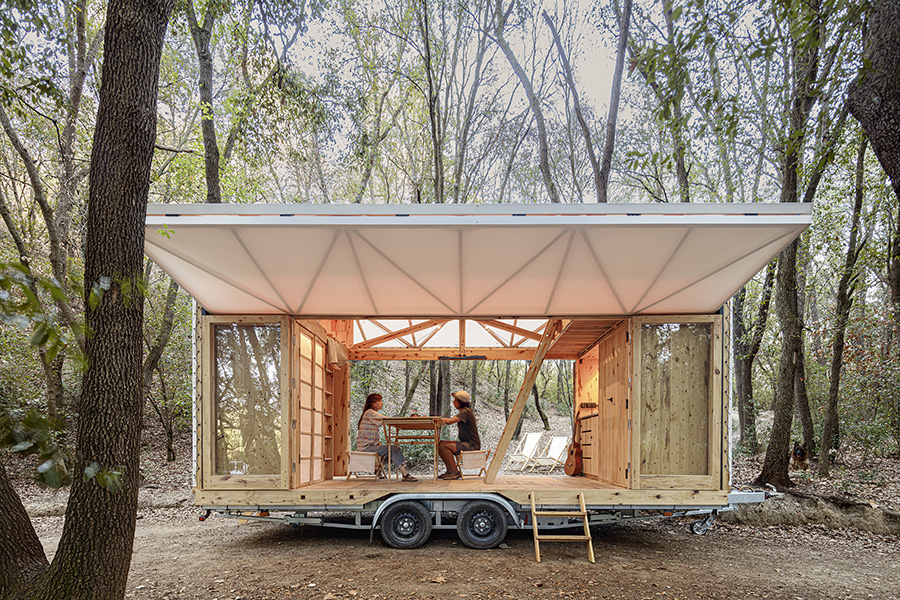
Architect: Institute of Advanced Architecture of Catalonia (IAAC) Valldaura Labs
Location: Barcelona, Spain
Type: Mobile Home
Year: 2024
Images: Adrià Goula
- MO.CA (MOBILE CATALYST) is an advanced and ecological mobile home built using ‘zero-kilometre’ natural materials and digital construction techniques produced at Valldaura Labs in the Natural Park of Collserola (Barcelona).
- The Mobile Catalyst (MOCA) has been developed by a team of students and researchers of the Masters programme in Advanced Ecological Buildings & Biocities (MAEBB) of the Institute for Advanced Architecture of Catalonia (IAAC).
The following description is courtesy of the architects. MOCA is a mobile dwelling made of 0km dowel-laminated timber produced by the Master in Advanced Ecological Buildings & Biocities programme at Valldaura Labs, from the Institute for Advanced Architecture of Catalonia (IAAC).
Throughout history, people have exercised their fundamental human right to liberty by combining self-sufficiency with movement, from migratory tribes through to interstellar explorers. In recent decades, the pursuit of self-sufficiency has been energized by the recognition of global climate change and the associated need to innovate resilient human habitations that meet contemporary requirements without relying upon fossil fuels. More recently still, the surge in remote work opportunities enabled by information and communications technology and prompted by COVID-19 renewed widespread interest in freedom of movement.
In this context, the 2022-2023 cohort of the Institute for Advanced Architecture of Catalonia’s (IAAC) Master in Advanced Ecological Buildings & Biocities (MAEBB) programme was presented with the brief to rapidly design and construct a prototypical mobile home accommodating two individuals with basic domestic amenities, to be constructed entirely of 0km timber sustainably harvested from the grounds of IAAC’s Valldaura Labs facility within the Collserola Natural Park and fully processed on-site. This construction should also allow other functions in its central space, such as spaces for concerts, events, a library or a meeting place, so that depending on its context it can have multiple functions.
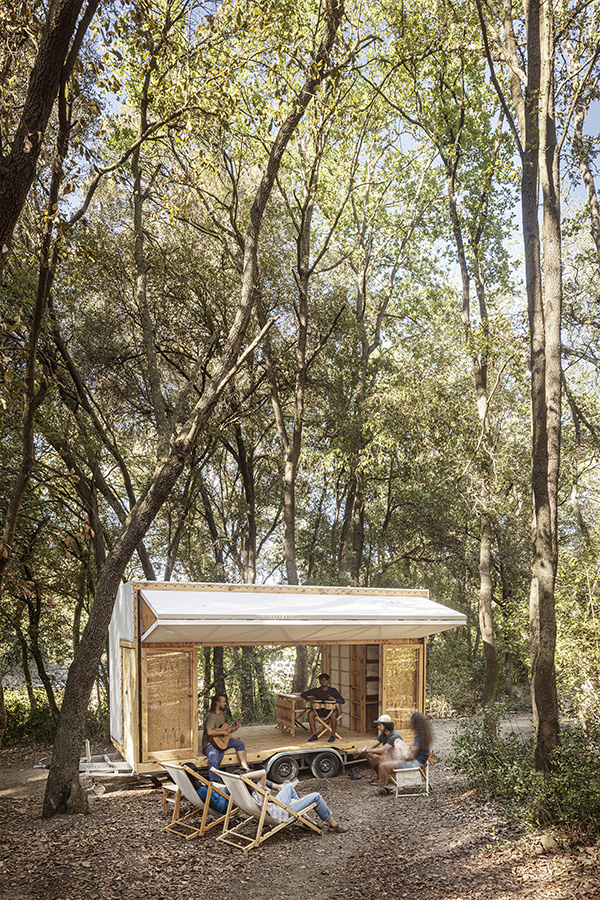
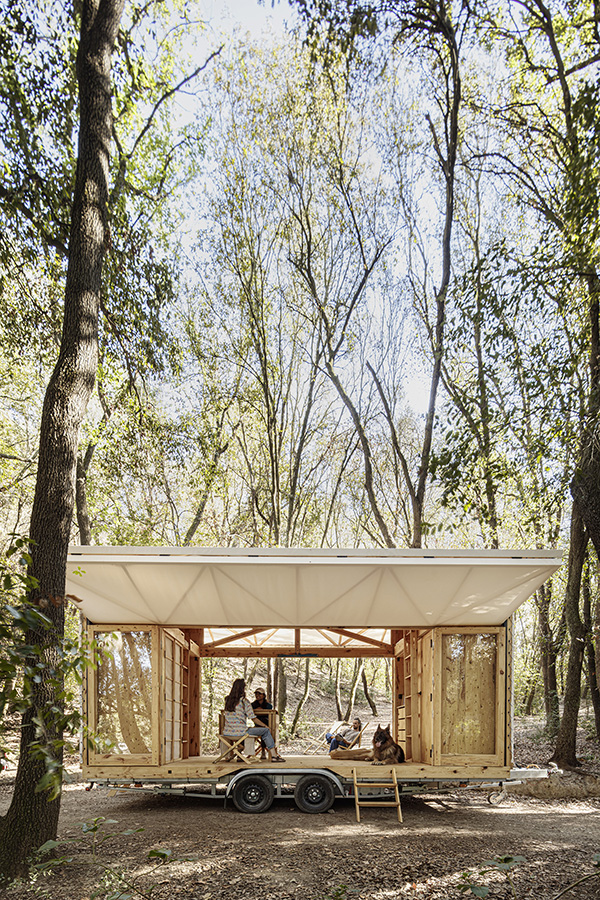
A mobile home designed and equipped to be self-sufficient
The mobility aspect of the brief instigated a conceptual journey bringing forth profound discussions on nomadism and collective sustenance, raising such questions as: how could a home take advantage of its mobility? Could it contribute to its immediate surroundings? Could the building allow collaboration and knowledge sharing? With these reflections in mind, a regenerative design was proposed that would connect, collect and share resources within networks.
The brief was extended from its initial definition of a home and developed to comprise an experiential engagement facilitator – a mobile catalyst – and thus the design was named MOCA. The main limitations arose from the trailer on which the home rests and local regulations. The final solution includes a platform 5.4 long and 2.4 wide on which the 3.6 m high house rests. The regulations also establish that the total weight of the construction (together with the trailer) cannot exceed 3,500 kg, and that the driver of the vehicle transporting the trailer must have Permit B96; values that became references and factors that influenced many design decisions.
The design of MOCA consists of two anchoring, solid toolboxes that contain tools and surfaces designed to initiate different activities in the central ‘reaction chamber’. The Toolbox A or Utility Toolbox is towards the front of the trailer and is the heavier toolbox. It includes all necessary utilities for a home; a kitchen, a shower area, a toilet, and a utility cabinet for electric and water metabolic systems.
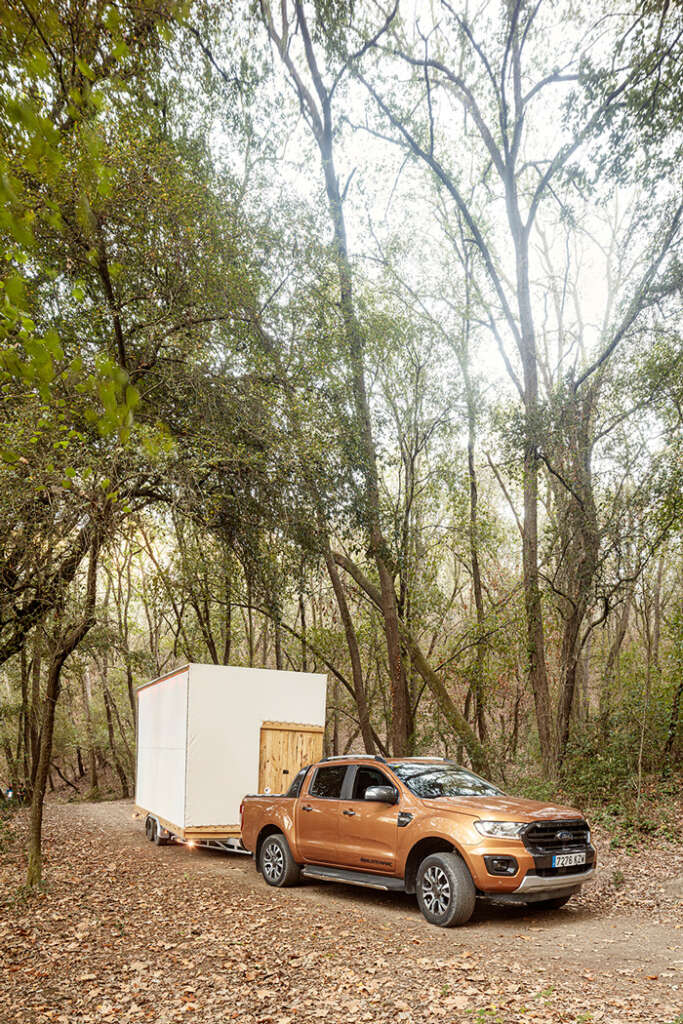
The Toolbox B or Activity Toolbox contains surfaces and tools that aid in activating the central space. An entrance door is provided on the Toolbox B side. It serves as the main access when the facade is closed or otherwise. The walls of the toolboxes are made with dowel laminated timber (DLT) panels of 4 cm thickness, mitigating the need for conventional toxic adhesives and maintaining the potential for circular reuse.
The operable facade of the mobile home consists of two complementary layers – a set of glass doors and a fabric facade – that together make it possible to adapt the degree of enclosure of the central space, adapting to the weather conditions, the time of day and the activity happening within. The glass doors (four on each side) are designed to be either open, semi-open or closed. When closed, the central space is sheltered from the outside environment. When open, the interior/exterior boundary is dissolved. The outer layer is designed as lightweight timber frameworks covered with a water-resistant cotton fabric, secured with threaded cord. On the two long sides, the facade slides and folds up with the mechanical advantage of pulleys.
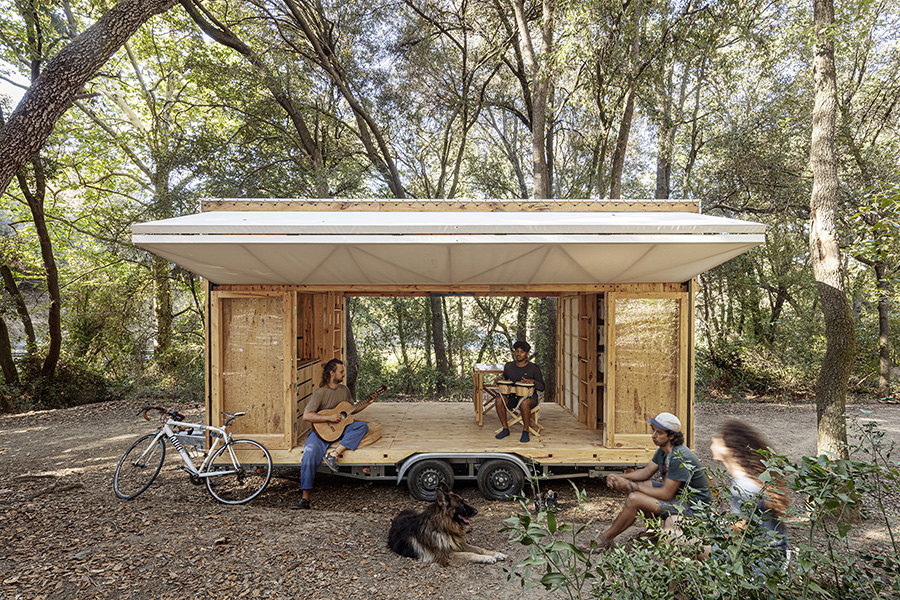
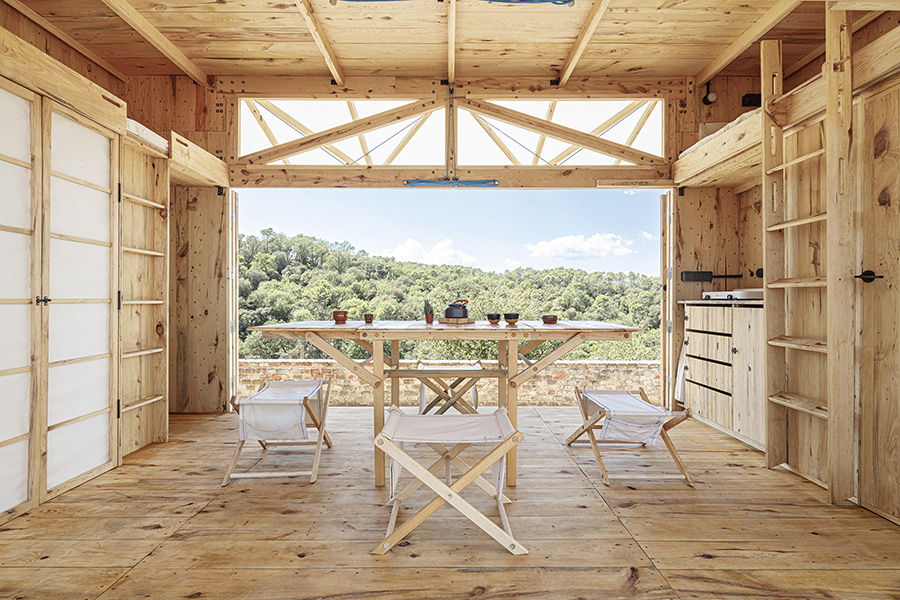
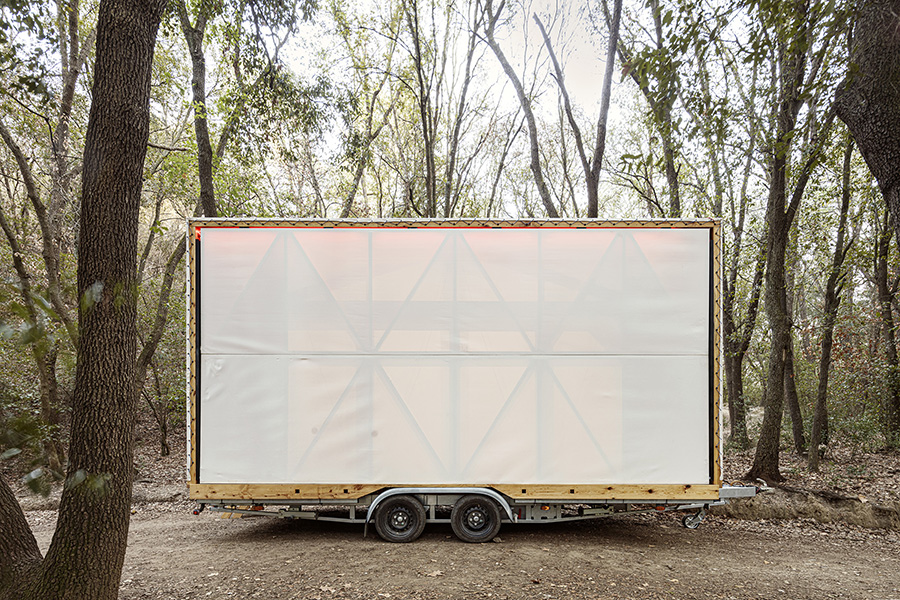
The mobile home obtains all of its energy from the sun and is equipped to sustain 24 hours of use without recharging. The energy consumption majorly consists of the media-related activities taking place inside and some basic home appliances. In line with the light fabric envelope placed on the roof, a set of 3 light-flexible monocrystalline solar panels connect to a MultiPlus inverter (which can also be connected to an external grid) and a battery backup. The interior and envelope are lit with LED strips, accentuating the textile enclosure with an internal glow.
Two beds (or sleeping shelves) are included on the mezzanine floor to leverage the verticality of the toolboxes (one of them extendable to two places). It comes with an extendable mattress that allows space for 2 people. A movable ladder accompanies the bed and is attached to the edge of the bed frame, which can be inclined for easier accessibility.
The kitchen includes a sink, a one-burner stove and drawers under the kitchen counter. A fridge is also provided along with spaces to hang utensils. Indicators for the battery level and tank water level are fitted at the kitchen wall. The washroom includes a waterless humus toilet box and a shower area. The humus toilet system does not include water for flushing, thus, eliminating any blackwater produced except that from cooking or cleaning. This saves the hassle of disposing of or treating black water. The shower water is collected in a catchment basin and stored in the grey water tank. It is then filtered and pumped to the recycled water tank and reintroduced to the system. The water is treated through a three-stage filter system, followed by a UV filter. The faucet handles permit inhabitants to switch between the water from the fresh water tank or the recycled water tank depending on their intended use. An inlet allows water to be pumped from external sources as well. The water from the kitchen sink is stored in the black water tank. This water is drained to external infrastructures for treatment. All water tanks are placed beneath the flooring, connected to the trailer, freeing up space for other utilities. The system works on a 12 V battery charged by solar energy, powering three circulatory pumps. Ball float sensors in tanks and a tank water level indicator have also been included for efficient maintenance.
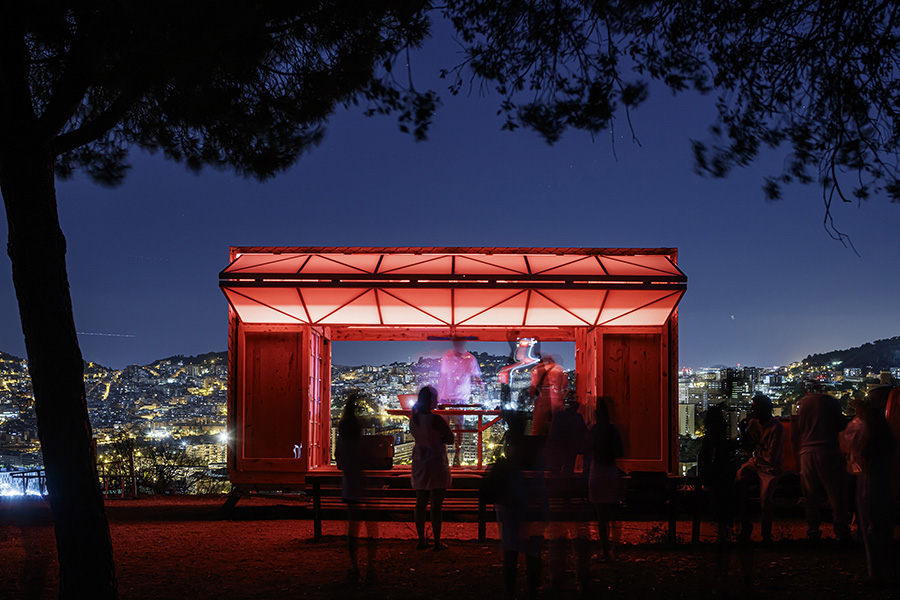
Toolbox B features a wardrobe storing the custom furniture. When outside, the furniture activates the space to host a variety of activities, for instance an office, workshops, exhibitions or concerts. The furniture is designed to fold and to occupy minimal space in this tiny home. The design is a combination of timber, fabric and dowels making for a lightweight setup. The integrated set includes a table, 6 stools, 2 lounge chairs and 6 Fab-kits. A pair of fabric belt straps are used to secure the furniture when the mobile home is on the road. The doors of the wardrobe are made with timber and fabric. These doors are also lightweight and follow a similar design style as the rest of the furniture with the fabric being a key element. Fab-kits, stored behind the mezzanine ladder and at the entrance door, include a first-aid kit, a fire extinguisher, and space for books, footwear, laundry and other objects. Underneath, 3 entrance ladders can be stored when not in use.
About IAAC
The Institute for Advanced Architecture of Catalonia (IAAC) is a center for research, training, production, and communication, located in Barcelona with 22 years of activity. Its objective is to lead the mission of imagining the future habitat of our society and building it in the present.
IAAC follows the digital revolution at all scales to push the boundaries of architecture and design to meet the challenges that humanity faces. IAAC is an experimental and experiential center where you learn by doing, through a testing methodology that promotes real solutions.
About MAEBB
The Institute for Advanced Architecture of Catalonia (IAAC) Valldaura Labs and its Masters programme in Advanced Ecological Buildings & Biocities (MAEBB) are engaged in the learning and development of ecological projects, parametric design techniques and the processing of locally-sourced materials. Valldaura Labs is known for its interest in exploring the boundaries of self-sufficiency, seeking to meet essential human needs, such as food, energy and everyday use objects, founded on the principle of a circular bioeconomy. In previous years, MAEBB students have produced award-winning projects such as the Quarantin Cabin, the Solar GreenHouse or FLORA.
Project Credits
- Direction: Vicente Guallart, Daniel Ibañez and Michael Salka
- Academic coordination: Esin Zeynep Aydemir
- Lab managers: Bruno Ganem Coutinho, Lorenzo Salinas
- Staff: Laia Pifarré, Pilar Fontanals, Laura Sanchez
- Designed and Developed by: The students of the Masters programme in Advanced Ecological Buildings & Biocities (MAEBB), 2022/23 class:
- Austin Brown, Basant Abdelrahman, Carla Alvear Arizaga, Jacek Antoni Kostrzewa, Jackie Williams, Julia Aurora Guzmán, Larsen Bidstrup, Raffaele Schiavello, Ruhani Adlakha, Sneham Pandey, Mariano Rodriguez Alonso, Sadegh Raoufi Fard, Charles Casbolt, Aishwarya Balsekar, Disha Arora, Indraneel Joshi, Laila Nabulsi, Nicolas Rotta, Nishanth Maheshwaran, Pradyumna Vikharankar, Prati Jain, Rujuta Chauhan, Shruti Sahasrabudhe and Santwana Malakar
- Host: Valldaura Labs of the Institute for Advanced Architecture of Catalonia
- Sponsors: Luz Negra, Tallfusta
- With the support of: Parc de Collserola
- Advised by: Jesus Bueno, Jochen Scheerer, Miquel Rodriguez, Thatcher Bean
- Photography: Adrià Goula
- Communication: Pati Nunez Agency
Discover more from reviewer4you.com
Subscribe to get the latest posts to your email.
